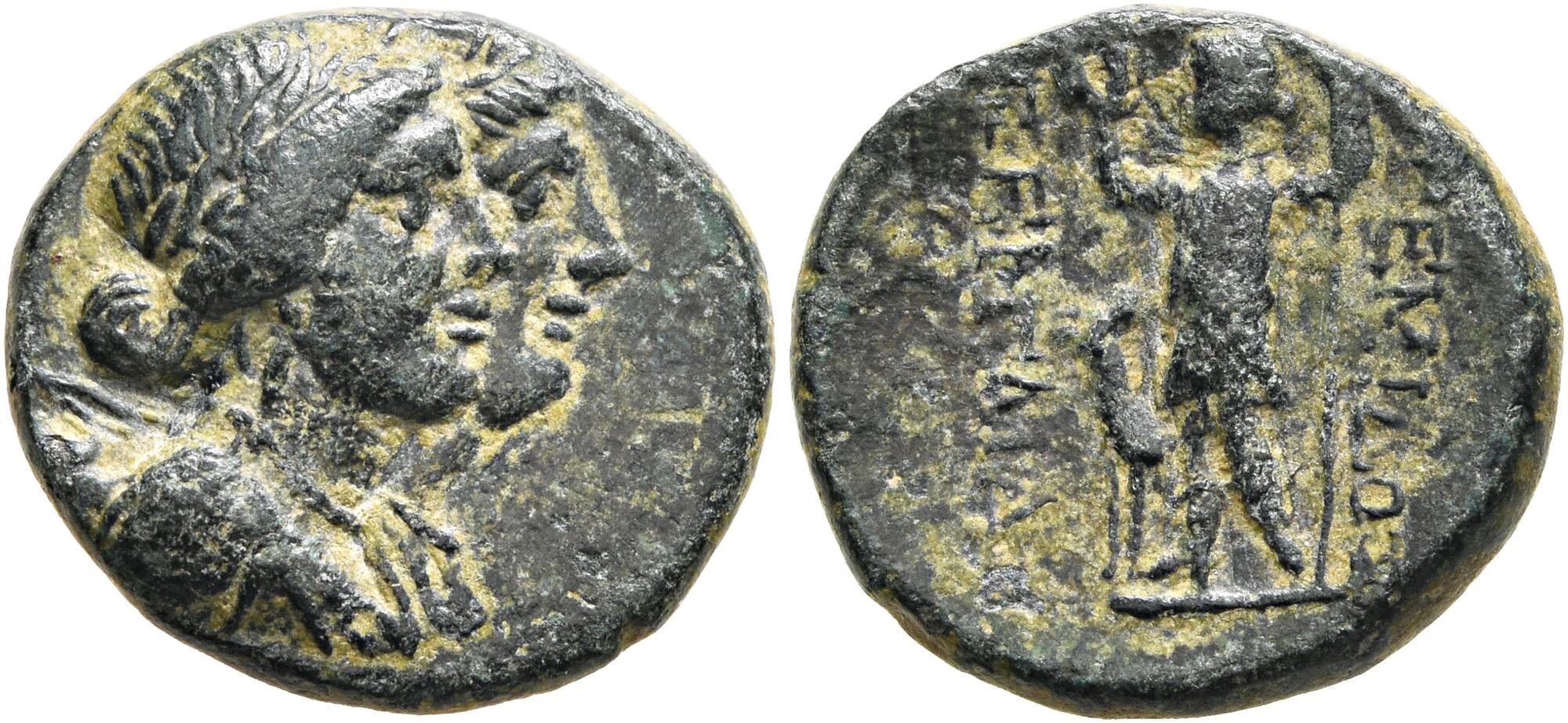Perge, bronze, 4g (Artemis-Apollo/Artemis) (160-90 BCE)
From SILVER
160 BCE - 90 BCE Bronze
Description
| ObverseInscription or printing placed on the obverse.: | Conjoined busts of Artemis, laureate, draped and with bow and quiver over her left shoulder, and Apollo, laureate and draped, to right |
| ReverseInscription or printing placed on the reverse.: | ΑΡΤΕΜΙΔΟΣ - ΠΕΡΓΑΙΑΣ (Greek).Artemis standing front, head to left, holding wreath in her right hand and scepter in her left, to left, stag to left |
Mint and issuing power
| MintIdentifies the place of manufacture or issue of a numismatic object.: | Perge | Ancient regionAncient region.: | Pamphylia | Modern countryModern country: Turkey | AuthorityIdentifies the issuing power. The authority can be "pretended" when the name or the portrait of X is on the coin but he/she was not the issuing power. It can also be "uncertain" when there is no mention of X on the coin but he/she was the issuing power according to the historical sources: |
Chronology
| FromIdentifies the initial date in a range assigned in a numismatic context. | 160 BCE | toIdentifies the final date in a range assigned in a numismatic context.. | 90 BCE | PeriodTime period of the numismatic object.: Hellenistic 323-30 BC |
Physical description
| MetalThe physical material (usually metal) from which an object is made.: | Bronze |
Median weightMedian of the weights of numismatic objects (in grams). in grams | 4.00 | DenominationTerm indicating the value of a numismatic object. Examples: tetradrachm, chalkous, denarius.: | StandardStandard.: |
Image

S1857 Perge bronze Artemis&Apollo Artemis.jpg [1]
References
| Die study referencePublication of the study: | Colin 19961Colin 1996, p. 67-70 | ||
| Coin series referenceReference to coin series study: | Sear II2Sear II, n° 5420 | ||
| Coin series web referenceCoin series web references: | |||
Obverse dies distribution
| FrequencyFrequency of specimen in distribution. ᵖ | Number of obversesNumber of obverse dies. ᵖ (o) | % (o) | Number of coinsNumber of coins. (n) | % (n) | Die nameName(s) of the die(s). |
| 1 | 9 | 33.33 | 9 | 13.64 | 2/1, 3/1, 3/3, 4/3, 6/4, 6/5, 7/2, 7/3, 7/8 |
| 2 | 8 | 29.63 | 16 | 24.24 | 1/1, 5/1, 6/2, 6/3, 7/4, 7/5, 7/7, 7/10 |
| 3 | 3 | 11.11 | 9 | 13.64 | 7/1, 7/6, 8/2 |
| 4 | 5 | 18.52 | 20 | 30.3 | 3/2, 4/1, 4/2, 6/1, 8/3 |
| 6 | 2 | 7.41 | 12 | 18.18 | 7/9, 8/1 |
| Total | 27 of 27 | 100 | 66 of 66 | 100 |
Reverse dies distribution
no distribution is available
Quantification
| Number of obversesNumber of obverse dies. ᵖ (o) | 27 | Number of singletons (o1)The number of singleton coins. ᵖ | 9 |
| Number of reverse diesNumber of reverse dies. (r) | 53 | Number of coinsNumber of coins. (n) | 66 |
| Coins per obverse dieNumber of coins per obverse die. (n/o) | 2.44 | Coins per reverse dieNumber of coins per reverse die. (n/r) | 1.25 |
| Reverse per obverse ratioRatio of obverse dies divided by reverse dies. (r/o) | 1.96 | Percentage of singletons (o1)number of coins (n) divided by the number of singletons (o1) ᵖ | 33.33 % |
| Original number of dies (O) (Carter 1983 formula)The estimation of the number of coins according to Carter 1983 ᵖ | 38.12 | Coins struck if 20,000 as average productivity per dieCoins made if the average productivity for obverses (according to Carter) is 20,000. ᵖ | 762,400 |
| Original number of dies (O) (Esty 2011 formula)The estimation of the number of coins according to the singleton formula in Esty 2011 ᵖ (O) | 45.69 | Survival rate if 20,000 as average productivity per dieSurvival rate if average productivity is 20,000. ᵖ | 0.00009 |
| Coverage (o = % of O) (Esty 1984 formula)Esty 1984 - coverage (% of O) ᵖ (o = % of O) | 86.36% | Die productivity if survival rate 1/2,000Average productivity if survival rate is 1/2,000. ᵖ | 3,462.75 |
| Weight of silver (in kg) if 20,000 coins per die (O = Carter formula)Carter 1983 * Median weight * 20000 (*10 if gold or electrum) ᵖ | n.a. | Die productivity if survival rate 1/5,000Average productivity if survival rate is 1/5,000. ᵖ | 8,656.87 |
Remarks
Most likely one single workstation